- Joined
- 29 Feb 2024
- Messages
- 5
- Reaction score
- 0
- Country

Hello,
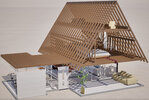

I am looking to better insulate my parent’s 1970’s chalet bungalow as the upstairs is noticeably warmer than the downstairs. The upstairs also gets very hot in summer and cold at night and the living room downstairs can be very cold in the winter. The living room has large windows and two and a half of the walls are exterior walls, but I hope insulating above will help retain more heat. I’m not in a position to be redecorating apart from perhaps removing part of the ceiling in the hallway cupboards, to gain access to the flat roof to push insulation into it.

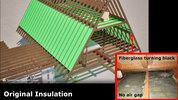 The original fibreglass, (shown in green), is about 60mm thick. The loft insulation is patchy in places and on the angled roof sections it is pushed up against the roofing felt and has no air gap at either the bottom where it meets the bricks or the top where it reaches the loft. At the top near the loft the fibreglass has turned black, presumably due to moisture making its way from the crawl space up into the loft. I can't see any evidence of mould or moisture on the joists.
The original fibreglass, (shown in green), is about 60mm thick. The loft insulation is patchy in places and on the angled roof sections it is pushed up against the roofing felt and has no air gap at either the bottom where it meets the bricks or the top where it reaches the loft. At the top near the loft the fibreglass has turned black, presumably due to moisture making its way from the crawl space up into the loft. I can't see any evidence of mould or moisture on the joists.
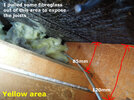 Both the loft and crawl spaces are used for storage. The crawl spaces have bits of plastic sheet and old carpet
Both the loft and crawl spaces are used for storage. The crawl spaces have bits of plastic sheet and old carpet 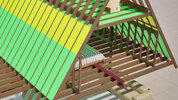 nailed against the angled roof section to reduce the amount of dust coming from the fibreglass. The space along the roof between the crawl space and the loft (shown in yellow) is 85mm at its narrowest due to battens used to attach plasterboard and is currently full of fibreglass with no airflow gap.
nailed against the angled roof section to reduce the amount of dust coming from the fibreglass. The space along the roof between the crawl space and the loft (shown in yellow) is 85mm at its narrowest due to battens used to attach plasterboard and is currently full of fibreglass with no airflow gap.
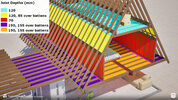 I plan to add more insulation on the loft floor (shown in light blue), insulate behind the knee walls (red), the gap below the knee wall to stop drafts under the floor and downstairs light fittings (pink), the crawl space floor and downstairs flat roof (purple), the gap between crawl space and loft, leaving an airflow gap between the roofing felt (yellow), and possibly the rest of the living room ceiling (orange) as I can access this area by pushing insulation under the floor from the crawl space.
I plan to add more insulation on the loft floor (shown in light blue), insulate behind the knee walls (red), the gap below the knee wall to stop drafts under the floor and downstairs light fittings (pink), the crawl space floor and downstairs flat roof (purple), the gap between crawl space and loft, leaving an airflow gap between the roofing felt (yellow), and possibly the rest of the living room ceiling (orange) as I can access this area by pushing insulation under the floor from the crawl space.
Regarding the pink areas, once this has effectively been sealed from airflow from the crawl space with insulation stuffed into it, what affect will it have on moisture in the orange area, particularly above the kitchen and bathroom which is downstairs? The upstairs has chipboard floorboards with one bedroom having laminate flooring and the other bedroom and the toilet a single piece of vinyl flooring each. Will moisture from downstairs be able to pass though without collecting and rotting the floor joists?
I’m also considering leaving part of the existing insulation (shown in green) by removing the top part that reaches from the crawl space to the loft.
to the loft.
I’m not sure what type of insulation I should use for each area. My understanding is that the rigid foam board type is tricky to fit in between joists and the inevitable gaps will affect the insulation properties. Please let me know what you think about the plan and which type of insulation to use.


I am looking to better insulate my parent’s 1970’s chalet bungalow as the upstairs is noticeably warmer than the downstairs. The upstairs also gets very hot in summer and cold at night and the living room downstairs can be very cold in the winter. The living room has large windows and two and a half of the walls are exterior walls, but I hope insulating above will help retain more heat. I’m not in a position to be redecorating apart from perhaps removing part of the ceiling in the hallway cupboards, to gain access to the flat roof to push insulation into it.

 The original fibreglass, (shown in green), is about 60mm thick. The loft insulation is patchy in places and on the angled roof sections it is pushed up against the roofing felt and has no air gap at either the bottom where it meets the bricks or the top where it reaches the loft. At the top near the loft the fibreglass has turned black, presumably due to moisture making its way from the crawl space up into the loft. I can't see any evidence of mould or moisture on the joists.
The original fibreglass, (shown in green), is about 60mm thick. The loft insulation is patchy in places and on the angled roof sections it is pushed up against the roofing felt and has no air gap at either the bottom where it meets the bricks or the top where it reaches the loft. At the top near the loft the fibreglass has turned black, presumably due to moisture making its way from the crawl space up into the loft. I can't see any evidence of mould or moisture on the joists. Both the loft and crawl spaces are used for storage. The crawl spaces have bits of plastic sheet and old carpet
Both the loft and crawl spaces are used for storage. The crawl spaces have bits of plastic sheet and old carpet  nailed against the angled roof section to reduce the amount of dust coming from the fibreglass. The space along the roof between the crawl space and the loft (shown in yellow) is 85mm at its narrowest due to battens used to attach plasterboard and is currently full of fibreglass with no airflow gap.
nailed against the angled roof section to reduce the amount of dust coming from the fibreglass. The space along the roof between the crawl space and the loft (shown in yellow) is 85mm at its narrowest due to battens used to attach plasterboard and is currently full of fibreglass with no airflow gap. I plan to add more insulation on the loft floor (shown in light blue), insulate behind the knee walls (red), the gap below the knee wall to stop drafts under the floor and downstairs light fittings (pink), the crawl space floor and downstairs flat roof (purple), the gap between crawl space and loft, leaving an airflow gap between the roofing felt (yellow), and possibly the rest of the living room ceiling (orange) as I can access this area by pushing insulation under the floor from the crawl space.
I plan to add more insulation on the loft floor (shown in light blue), insulate behind the knee walls (red), the gap below the knee wall to stop drafts under the floor and downstairs light fittings (pink), the crawl space floor and downstairs flat roof (purple), the gap between crawl space and loft, leaving an airflow gap between the roofing felt (yellow), and possibly the rest of the living room ceiling (orange) as I can access this area by pushing insulation under the floor from the crawl space.Regarding the pink areas, once this has effectively been sealed from airflow from the crawl space with insulation stuffed into it, what affect will it have on moisture in the orange area, particularly above the kitchen and bathroom which is downstairs? The upstairs has chipboard floorboards with one bedroom having laminate flooring and the other bedroom and the toilet a single piece of vinyl flooring each. Will moisture from downstairs be able to pass though without collecting and rotting the floor joists?
I’m also considering leaving part of the existing insulation (shown in green) by removing the top part that reaches from the crawl space
 to the loft.
to the loft.I’m not sure what type of insulation I should use for each area. My understanding is that the rigid foam board type is tricky to fit in between joists and the inevitable gaps will affect the insulation properties. Please let me know what you think about the plan and which type of insulation to use.

